Chickens lay eggs in so many colors, from chalky white to dark chocolate brown. They lay blue, green, pink, and even purplish eggs. And several chicken breeds lay speckled eggs, at least some of the time. Speckled eggs usually come from chickens that lay either darker brown eggs or the blue or green varieties. Many hybrid chickens, which combine two or more recognized breeds, also produce speckled eggs at least occasionally if one of their parent breeds is known to do so. The well-known Easter Egger hybrid, a mix of an Araucana or Ameraucana chicken and a breed that lays brown eggs, is a good example. Here are 10 chicken breeds that sometimes lay speckled eggs.
Welsummer Chicken
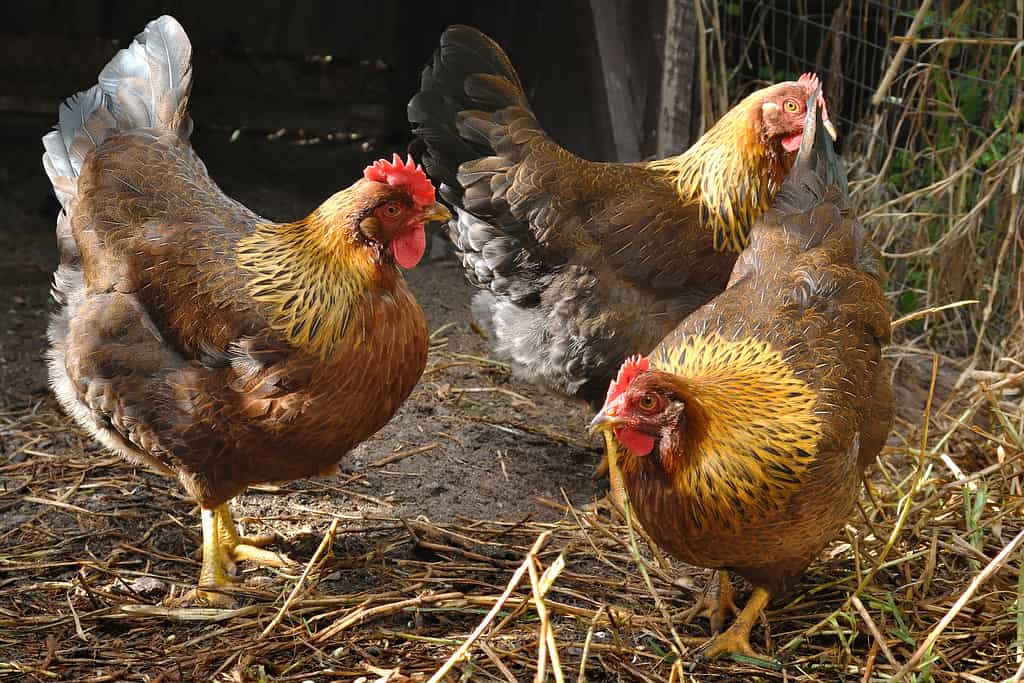
Welsummer hens, from the Netherlands, lay large, dark brown eggs.
©illarionovdv/iStock via Getty Images
The Welsummer chicken, originally from the Netherlands, may be the best-known breed that lays speckled eggs. These chickens lay large, dark brown eggs that often, but not always, come out speckled. Hens produce an average of 3 to 4 eggs per week.
Penedesenca Chicken

Penedesenca hens, from Spain, lay dark, reddish brown eggs.
©Maria Antònia Udina Castell / CC BY-SA 3.0 – License
The Penedesenca chicken, which originated in Spain, lays some of the darkest, reddish-brown eggs in the world. Their color ranges from chocolatey brown to terracotta. These chickens lay medium to large, sometimes speckled eggs. Hens produce roughly 3 to 4 eggs per week.
Marans Chicken
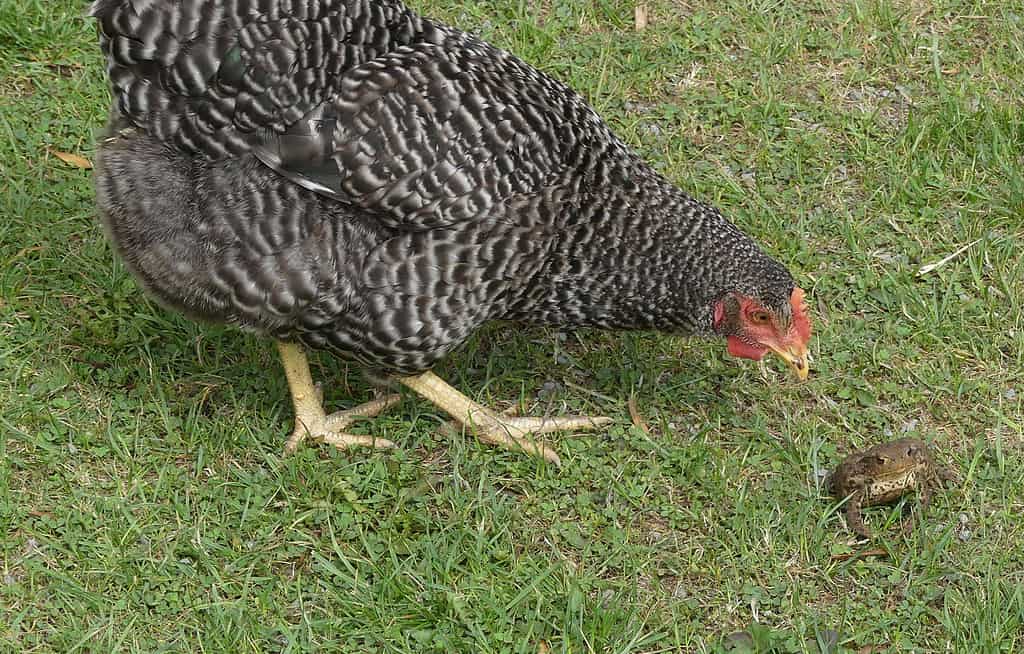
Marans hens, from France, lay rich, chocholate brown eggs.
©Stephen William Robinson/Shutterstock.com
The Marans chicken, originally from France, lays rich, dark, chocolate brown eggs so impressive that they were made famous by Ian Fleming in From Russia With Love as the only variety James Bond would eat. These chickens, known not only for their dark brown eggs but also the quality of their meat, lay large, sometimes speckled eggs. Hens produce around 3 to 4 eggs per week.
Barnevelder Chicken
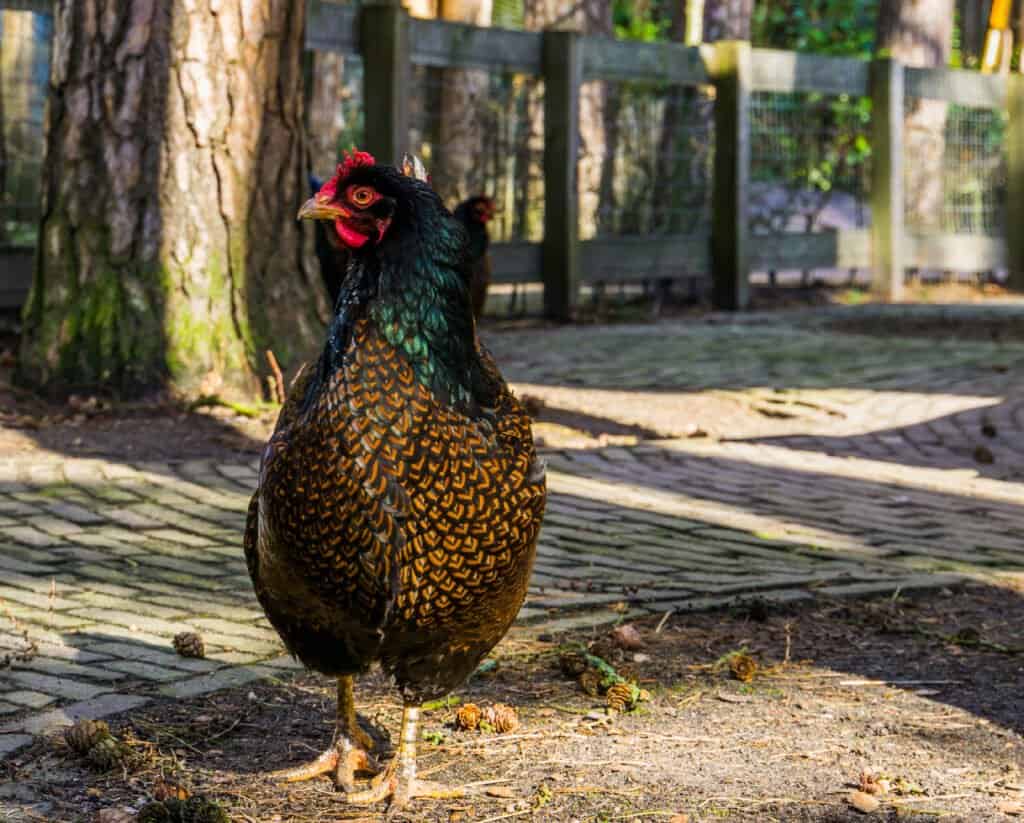
Barnevelder hens, from the Netherlands, also lay dark, chocolatey brown eggs.
©Charlotte Bleijenberg/Shutterstock.com
The Barnevelder chicken, which also arose in the Netherlands and was a contributor to the pedigree of the Welsummer chicken, lays dark, chocolate brown eggs. These chickens lay large eggs that often come out speckled. Barnevelder hens, well known for their uniquely patterned feathers with delicate markings, produce between 3 to 4 eggs per week.
Langshan Chicken

Langshan chickens produce dark brown eggs with a strong purple tint that resemble plums.
©John Touscany/iStock via Getty Images
The Langshan chicken, which originated in the Langshan area of China, lays medium to dark brown eggs. Langshan eggs sometimes have such a prominent purple tint that people describe the color as plum. Their eggs are truly among the most uniquely colored of all recognized breeds. These chickens lay large, sometimes speckled eggs. Hens produce an average of 3 to 4 eggs per week.
Jersey Giant Chicken

Jersey Giant hens lay eggs that vary in color from very light brown to dark brown.
©Finnegan’s Fotos/Shutterstock.com
The enormous Jersey Giant chicken, one of the largest chickens in the world reaching weights of up to 15 pounds, originated in New Jersey in the United States. It lays eggs that vary in color from very light to dark brown. These chickens lay large, sometimes lightly speckled eggs. Hens produce approximately 2 to 4 eggs per week.
Rhode Island Red Chicken

Rhode Island Red hens lay light brown eggs in large quantities.
©Nadanka/iStock via Getty Images
The Rhode Island Red chicken, which originated as one might expect, in Rhode Island, lays light brown eggs. This breed arose from crosses between a Malay chicken and several other breeds, and it currently ranks as one of the most popular chickens in the world. Rhode Island Red chickens rank as the most abundant layers on this list, producing 200 to 300 eggs per year or more. They lay large, sometimes speckled eggs. Hens produce up to 4 to 6 eggs per week.
Plymouth Rock Chicken
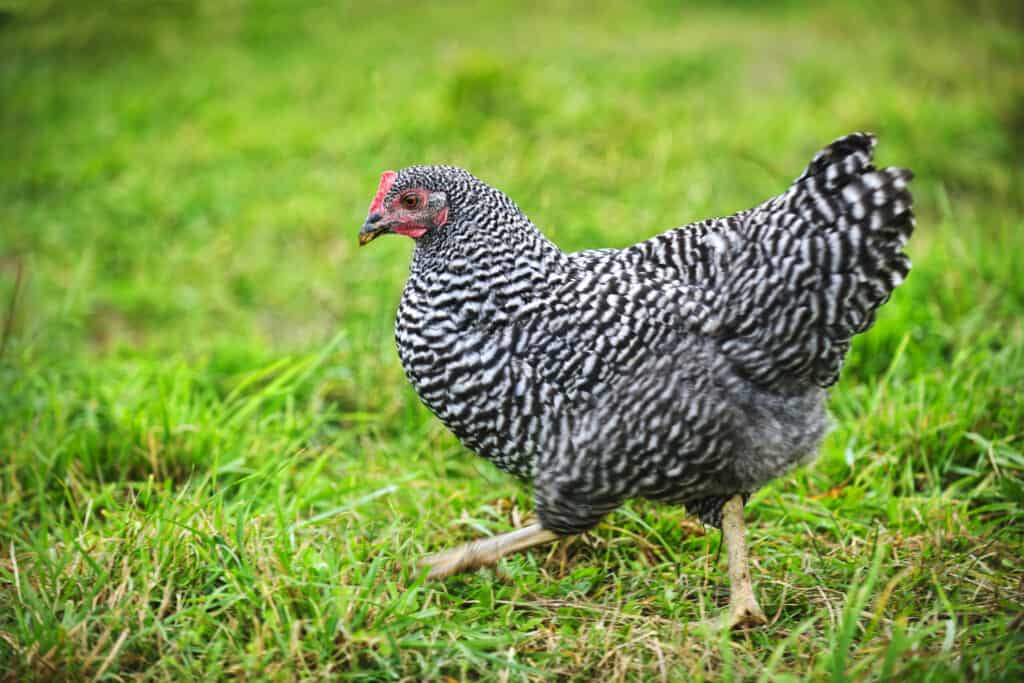
Plymouth Rock hens lay abundant brown eggs of a medium hue.
©iStock.com/Elenathewise
The Plymouth Rock chicken originated in Massachusetts, and though recognized in several different colors remains most popular for the barred variation known as the Barred Rock. These chickens produce large quantities of eggs, though not as many as the Rhode Island Red. They lay large, medium brown, sometimes speckled eggs. Hens produce approximately 4 to 5 eggs per week.
Araucana Chicken

Araucana hens from South America are famous for their blue to bluish-green eggs.
©Vampyre Zen/Shutterstock.com
The Araucana chicken, named for the Araucania region in Chile, arose in South America. This breed is famous for its beautiful blue or blueish-green eggs, a trait seldom seen in other breeds. Unfortunately, it is also known for carrying lethal genes. The few other known breeds that also produce blue eggs, such as the Ameraucana, all trace back to the Araucana. The Araucana chicken lays medium to large, sometimes speckled eggs. Hens produce roughly 5 eggs per week.
Ameraucana Chicken
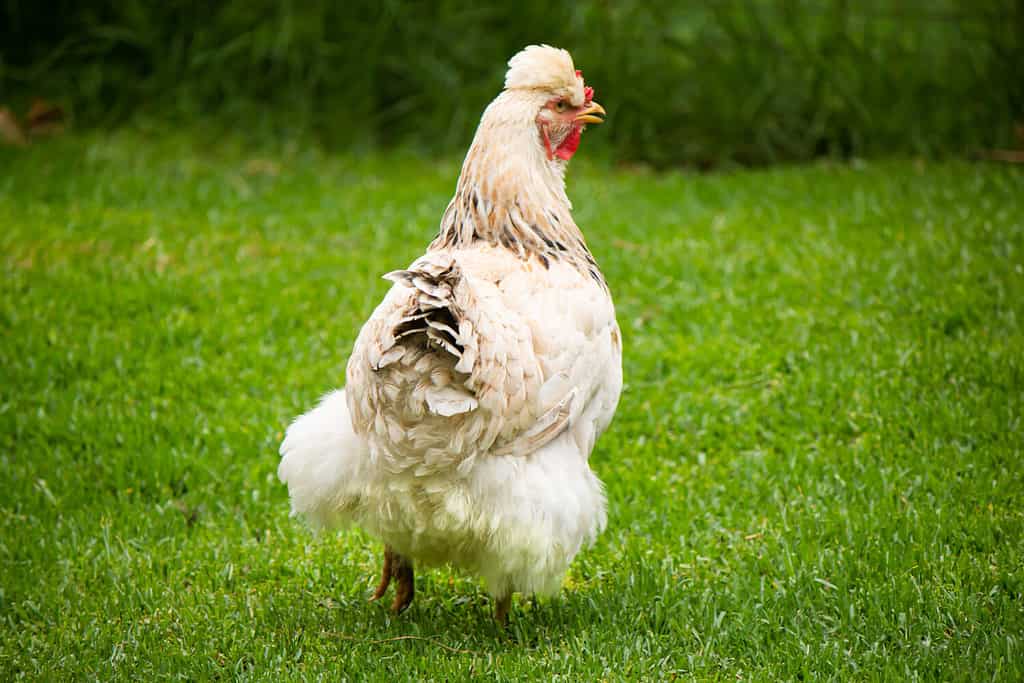
Ameraucana hens, developed in the United States, also lay blue to bluish-green eggs.
©Vampyre Zen/Shutterstock.com
The Ameraucana chicken, bred from the Araucana chicken, originated in the United States in the 1970s. Breeders successfully kept the highly desirable blue or blueish-green eggs when developing the Ameraucana, but eliminated lethal genes that plague the Araucana. The Ameraucana chicken lays medium, sometimes speckled eggs. Hens produce an average of 3 to 4 eggs per week.
What Causes Speckled Eggs
An organic molecule called Protoporphyrin IX, necessary for the manufacture of hemoglobin, also acts as a pigment causing brown coloration on eggshells. The more of this molecule a chicken produces, the darker brown their eggs will be. When a chicken lays speckled eggs, it is because the pigment is unevenly distributed across the surface of the egg. This usually happens because the egg has spun too slowly as it moved through the oviduct. Eggs do not always move through hens at the same pace or in the same way. Many factors can affect how eggs are produced, including stress, illness, diet, and more. That helps explain why the same hen may produce speckled eggs sometimes and solid-colored eggs at other times.
What Other Chickens Lay Speckled Eggs?
Most chickens that lay colored eggs have the potential to lay speckled eggs, if only rarely. Chickens bred from other breeds that produce speckled eggs often will probably also produce eggs with speckles at least part of the time. There are many unrecognized hybrids, such as the Easter Eggers and Olive Eggers, which are well known for occasionally laying speckly eggs. Don’t be surprised if you see speckles from time to time. They don’t hurt the quality of the egg at all.
Summary
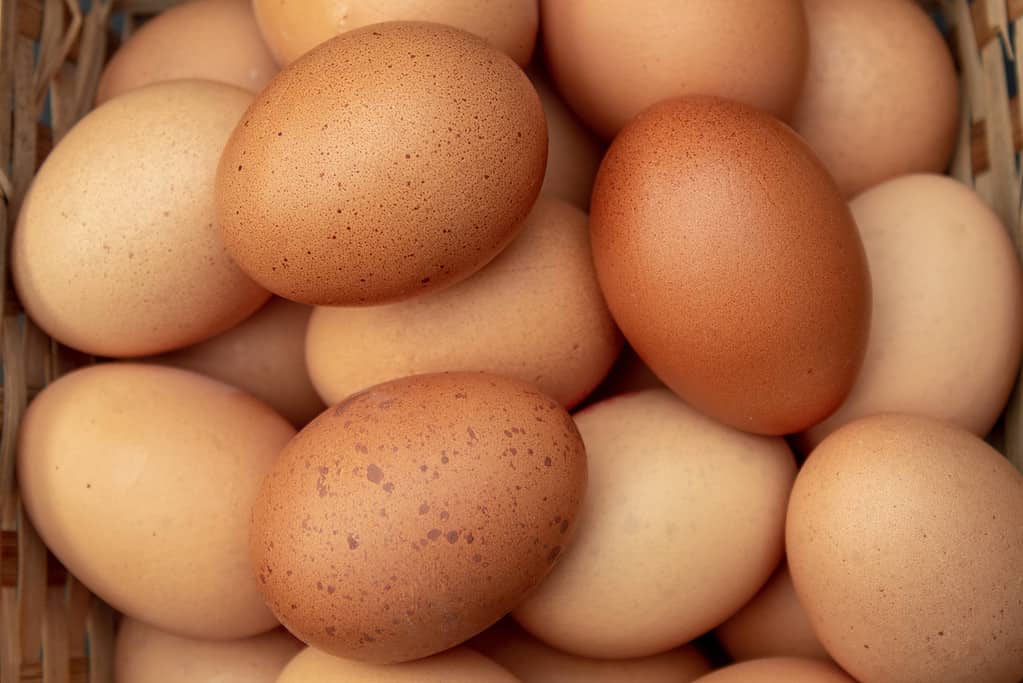
Speckled eggs add interest and variety to your basket.
©EMFA16/iStock via Getty Images
Here is a chart that shows the chicken breeds from this article, all of which lay speckled eggs at least part of the time. As you can see, chickens that lay speckled eggs come from all over the world. This chart lists the breeds , their egg colors, the number of eggs that they lay each week, and their places of origin.
| Breed | Egg Color | Number of Eggs | Place of Origin |
|---|---|---|---|
| Welsummer | Rich, dark brown | 3 to 4 per week | Netherlands |
| Penedesenca | Dark, reddish brown | 3 to 4 per week | Spain |
| Marans | Dark, chocolate brown | 3 to 4 per week | France |
| Barnevelder | Dark, chocolate brown | 3 to 4 per week | Netherlands |
| Langshan | Medium to dark, purplish brown | 3 to 4 per week | China |
| Jersey Giant | Light to dark brown | 2 to 4 per week | New Jersey |
| Rhode Island Red | Light brown | 4 to 6 per week | Rhode Island |
| Plymouth Rock | Medium brown | 4 to 5 per week | Massachusetts |
| Araucana | Blue to blueish-green | 5 per week | Chile |
| Ameraucana | Blue to blueish-green | 3 to 4 per week | United States |
The photo featured at the top of this post is © EMFA16/iStock via Getty Images
Thank you for reading! Have some feedback for us? Contact the AZ Animals editorial team.







